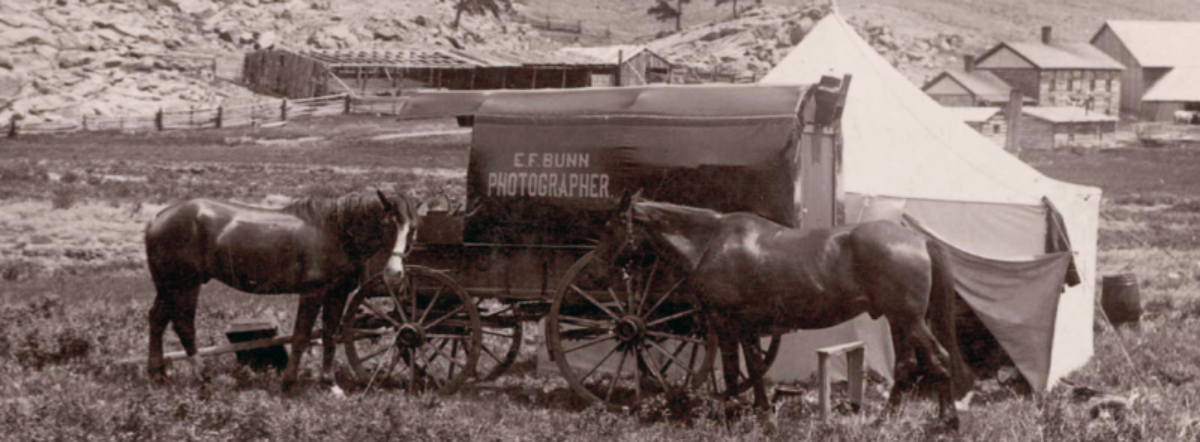In 1859, overblown reports of gold discovered along Denver’s Cherry Creek brought a stampede of newcomers to the sparsely populated area, including a few photographers. But it was George D. Wakely who stayed for five years and produced a large body of work that continues to inspire and inform researchers today.
George D. Wakely was born in England circa 1836. It is not known when he arrived in the United States, but in 1855 Wakely was living in New York City with his wife, Mathilda Brown and four children from her previous marriage. (The New York State Census for that year lists Jos. B. Wakeley, age 38, born in England, working as a photographer. While his name and age are incorrect, I believe this is George D. Wakely, as his wife, Matilda, and her four children are also listed.)

The following year, Wakely moved west to Chicago where he made ambrotypes. His peripatetic nature led the Wakely family to Leavenworth, Kansas, in the late 1850s, where George’s three step-daughters, Rose, Louise and Flora, acted in Colonel Charles S. Thorne’s Star Company. They performed under the last name Haydee. George was active behind the scenes. The theatrical troupe was invited to perform in Denver, a city less than two years old. The troupe loaded up five ox-drawn wagons for the five-week journey to Colorado, arriving in September 1859. Thorne’s Star Company was the first theatrical company to perform in the “Territory of Jefferson” at Denver’s Apollo Theatre. After only six performances and rave reviews, Thorne secretly left Denver and returned to Leavenworth. Undeterred, the Wakely women established their own troupe, the Haydee Star Company.
Meanwhile, George Wakely opened Denver’s first photographic gallery across the street from the Apollo Theatre in 1859. He produced ambrotypes and photographs on leather. The latter could be easily sent through the mail to Easterners. His half-plate ambrotype of Mademoiselle Carolista, an itinerant tightrope walker, performing across Larimer Street on July 18, 1861 is held by History Colorado.

In June 1862, Wakely built a new gallery on Larimer Street across from the post office. He obtained the latest equipment from New York, and offered the new carte de visite photographs, as well as ferrotypes. Later that year he enhanced his studio with a mammoth sky light and extra side lights. In addition to his own photographs, he also sold views of Colorado’s mountain scenery by photographer Henry Faul.
In April 1864, Wakely put his gallery up for sale due to health concerns, offering to teach the art to the buyer. When no interested parties materialized, Wakely continued to photograph Denver and its environs, documenting the May 1864 Cherry Creek flood.

On June 27, 1864, Wakely announced: “I will close my photographic rooms in a few days. Patrons are requested to call and get their pictures. A few more views of the flood left for sale.”

In October 1864, he copyrighted 26 photographs with the First Judical District of Colorado Territory, including views of the Garden of the Gods, Central City, Black Hawk, and mining views in North Empire.
Wakely had closed his gallery and moved New York by February 1865. At that time he offered his Rocky Mountain and mining views for sale in Harper’s Weekly magazine. But later that year, Wakely, now living in Washington, DC, with a studio at 524 Pennsylvania Avenue, produced a series of stereoviews documenting government buildings.

In 1869 or 1870 Wakely opened a photographic supply store in Kansas City, publishing a catalog of the materials he offered for sale. He ran this business until 1877 when he sold out to Fred Mullett. During this time, Wakely also wrote articles for professional photograph journals.
In the summer of 1877 Wakely relocated to Los Angeles, running a livery stable. He returned to Colorado in 1879, working in Leadville, and the following year he was back in the photo business with Edward N. Clements as Wakely & Clements.
By 1884, Wakely was on the move again, this time to Dallas, Texas. He was employed by Alfred Freeman, a photographer and dealer in pianos and organs. Working as a traveling salesman based out of Waco, Texas, Wakely sold pianos and organs in 1888 and 1889. By 1890, he had again opened a photography studio, this time in McKinney, Texas, while also still selling pianos. In 1894 he joined forces with photographer William F. Cobb, operating as Wakely & Cobb until March 1897. In November 1898, Wakely started a new gallery in McKinney in the Dr. Metz building. He worked there until 1901 when he accepted a job for a Dallas music company as a traveling salesman. For the next several years, Wakely’s photography took him to various towns in Texas and Oklahoma, before retiring in Dallas.
In April 1922, Wakely was hit by a car or train. He died from his injuries on April 22, 1922. Wakely was survived by his second wife, Etta R. Lawrence. He is buried at Grove Hill Memorial Park, Dallas.
